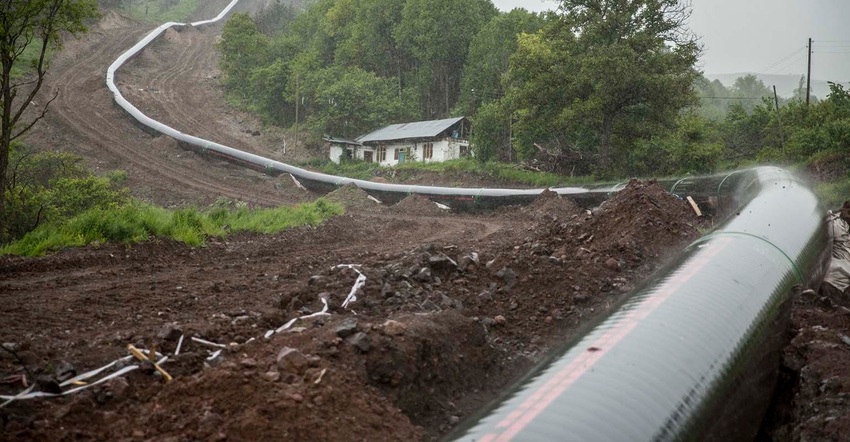
by Jillian Goodman
“When I first started this, it was about my house,” said Shannon Graves, who owns a hardware store in Polk, Neb.—population roughly 300—and lives less than 100 yards from the proposed route of the Keystone XL pipeline. “I just wanted to protect my home.”
That was six years ago. Now, Graves said, “what was once just my home is now my world that I’m standing to protect.”
So last week she headed to Lincoln, the state capital, for hearings to determine whether the pipeline would serve Nebraskans’ public interest, the final regulatory hurdle for the long-contentious project.
After years of protest by environmentalists, the Obama administration in 2015 rejected TransCanada’s proposal for the 1,179-mile pipeline, which would deliver crude oil from the Alberta tar sands to the Gulf of Mexico. In January, President Donald Trump resurrected the project with a presidential memo and executive order.
On a national level, the pipeline has been opposed largely by environmentalists, but in Nebraska, it’s been fought mainly by farmers and ranchers who fear it could erode their soil and hurt their land values. Last week, a number of them—now educated in the intricacies of property easements, eminent domain, and bitumen—testified before the state’s Public Service Commission, hoping to persuade its members to reject it.
TransCanada maintains the pipeline project would be an economic boon to the state. “The public benefit for Nebraskans is quite significant,” said spokesman Matthew John. “We’re talking about 4,400 jobs, direct and indirect”—that is, jobs building the pipeline and jobs with other employers expected to benefit, such as local restaurants and stores—“and tens of millions of dollars in state property taxes that will be paid out throughout the life of the project. As well as the economic benefits that are generated from construction.”
But Nebraskan opponents argue that the vast majority of the jobs TransCanada has said the pipeline would create are construction-related and therefore short-term; those jobs, along with such indirect benefits as greater spending in local establishments, would evaporate once the project is completed. And tax revenue, they say, would evaporate in not much longer: The taxable value of the pipeline itself will depreciate over 15 years and payments gradually dwindle to zero.
The pipeline’s current proposed route would cross the farm that Art Tanderup, a retired teacher and perhaps the landowners’ breakout star, owns with his wife, Helen. After the hearings finished, Tanderup said he felt he and the other landowners had gotten a chance to educate the PSC on life for Nebraska farmers. “You get big corporate people coming in—they don’t know us, they don’t know Nebraska,” he said.
Keystone XL is meant to be an extension of an existing Keystone pipeline that runs north-south through the eastern portion of the state. TransCanada has argued that its proposed route for the XL—which would cut diagonally across the state, crossing the Ogallala Aquifer, the historic Ponca Trail of Tears, and a small portion of the fragile Sandhills region—is the safest and most environmentally friendly path. Other than an earlier route, nixed years ago under pressure by the governor and the federal government, it’s also the most direct route from the Canadian tar sands to the existing pipeline junction in Steele City, Neb..
Although the landowners would prefer that the PSC reject the pipeline entirely, their lawyers argued that the more responsible route would be one that parallels the existing pipeline, creating an energy corridor that would avoid disturbing additional land. On the first day of the proceedings, under questioning by the landowners’ lawyers, TransCanada’s representatives acknowledged that collocating the two pipelines would mean crossing fewer miles of Nebraska farmland and that because they weren’t locked into a route in South Dakota for the XL, they wouldn’t need additional approval to do so.
After the hearings concluded Thursday morning, a day and a half ahead of schedule, the landowners’ lawyers said they were pleased with what they’d presented. “Our pitch is, look at the net benefit,” lawyer Brian Jorde said. “It can’t be, ‘Is this just the not-so-bad pipeline?’ If it’s not a net benefit to the state, we don’t need it.”
TransCanada’s lawyers, James Powers and Patrick Pepper of the firm McGrath North, left shortly after the hearing without answering questions and didn’t respond to a previous interview request.
PSC spokeswoman Deb Collins said in an email that commissioners could not comment given the ongoing legal proceeding. The commission has until Nov. 13 to decide.
Regardless of its decision, opponents said they still expect to wind up in court over the pipeline, perhaps in eminent-domain battles over efforts to build it on their land.
“We are exhausted,” Graves said. She’s been opposing the pipeline for six years now, others for even longer. But she added: “My daddy raised me to never give up. You just never give up. There’s too much at stake to give up.”
To contact the author of this story: Jillian Goodman in New York at [email protected]
To contact the editor responsible for this story: Samantha Schulz at [email protected]
© 2017 Bloomberg L.P
About the Author(s)
You May Also Like




